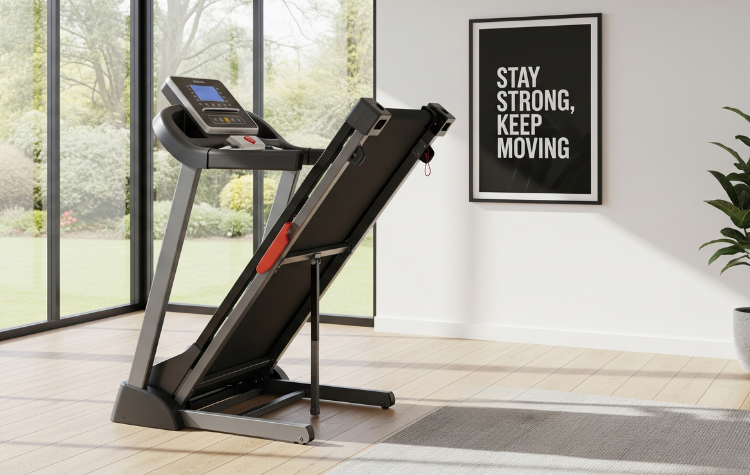
I Want To Buy a Foldable Treadmill: What do I Need to Know?
Share
When you decide to buy a foldable treadmill, you're choosing a fitness solution that maximizes workout potential while minimizing space requirements. These innovative machines have revolutionized home fitness by offering the full benefits of treadmill training in a compact, storage-friendly design that adapts to modern living spaces.
Understanding Foldable Treadmill Advantages
The decision to buy a foldable treadmill addresses one of the most common barriers to home fitness equipment ownership: space limitations. Traditional treadmills can consume 30-35 square feet of floor space permanently, making them impractical for apartments, condos, or homes with limited room. Foldable treadmills solve this challenge by reducing storage footprint by 50-70% when folded, transforming from a full-sized exercise machine into a compact unit that fits against walls or under beds.
Beyond space savings, foldable treadmills offer psychological benefits that shouldn't be overlooked. The ability to quickly set up and store your equipment removes barriers to regular exercise. When your treadmill can be deployed in minutes and stored just as easily, you're more likely to maintain consistent workout routines without feeling overwhelmed by permanent equipment dominating your living space.
Folding Mechanisms and Engineering
When you buy a foldable treadmill, understanding the folding mechanism is crucial for long-term satisfaction. The most common design features a hydraulic-assisted folding system that allows the running deck to lift vertically against the console. Quality hydraulic systems provide smooth, controlled motion in both directions, preventing sudden drops that could damage the machine or cause injury.
Manual folding mechanisms represent a more budget-friendly option but require physical strength to lift and lower the deck. These systems typically use spring-loaded pins or latches to secure the deck in folded position. While functional, manual systems may discourage frequent folding and unfolding, potentially defeating the space-saving purpose.
Premium foldable treadmills feature soft-drop technology that controls the deck's descent when unfolding, ensuring gentle, safe operation. This feature becomes particularly important for heavier decks and prevents the jarring impact that can damage internal components over time.
Stability and Performance Considerations
A common concern when planning to buy a foldable treadmill involves stability compared to non-folding models. Modern engineering has largely addressed these concerns through reinforced frame construction and strategic weight distribution. Quality foldable treadmills incorporate steel reinforcement at folding joints and use heavy-duty hinges rated for thousands of folding cycles.
The key to foldable treadmill stability lies in the base design and weight distribution. Look for models with wide, stable bases that extend beyond the folded deck footprint. Anti-vibration feet and rubber pads help maintain stability during vigorous workouts while protecting floors from damage.
Performance characteristics of foldable treadmills have improved dramatically as manufacturers optimize motor placement and belt systems for folding designs. Modern foldable models offer comparable motor power, belt size, and speed ranges to traditional treadmills, with many featuring 2.0-3.0 CHP motors and running surfaces up to 20" wide by 55" long.
Space Requirements and Storage Planning
Before you buy a foldable treadmill, carefully measure both your workout space and intended storage area. When deployed, foldable treadmills require similar floor space to traditional models – typically 6-7 feet in length and 3-4 feet in width. However, ensure adequate ceiling height for safe folding operation, as the vertical storage position may add 12-18 inches to the machine's height.
Storage space planning involves more than just floor area. Consider the folded dimensions carefully, including width, depth, and height. Some models fold to just 10-12 inches in depth, making them suitable for storage behind doors or in closets. Others maintain 18-24 inch depth when folded, requiring dedicated wall space or storage areas.
Weight considerations become important for frequent movers or those planning to store their treadmill in different locations. While foldable treadmills typically weigh 100-200 pounds, built-in transport wheels can facilitate movement when folded. However, stairs or elevation changes may still require assistance or professional moving services.
Weight Limits and Durability Factors
Foldable treadmills traditionally featured lower weight limits than their non-folding counterparts due to engineering constraints at folding joints. However, modern designs have largely eliminated this limitation. Quality foldable treadmills now support 250-350 pound weight limits, comparable to traditional models.
When you buy a foldable treadmill, examine the weight rating carefully and select a model rated at least 50 pounds above your body weight. This margin ensures optimal performance and extends machine lifespan, particularly important given the additional stress placed on folding mechanisms during use.
Durability concerns center around the folding mechanism itself. Quality models use heavy-duty hinges, reinforced mounting points, and corrosion-resistant hardware designed for thousands of folding cycles. However, frequent folding and unfolding does introduce additional wear points compared to stationary treadmills.
Essential Features for Foldable Models
Smart feature integration has become standard when you buy a foldable treadmill. Many models include Bluetooth connectivity, app integration, and built-in workout programs despite their compact design. Touch screens, USB charging ports, and device holders maintain user convenience without compromising the space-saving benefits.
Safety features deserve special attention in foldable designs. Emergency stop mechanisms, safety keys, and handrail placement must accommodate both folding and operation modes. Quality models include safety locks that prevent accidental folding during use and secure latching systems that maintain folded position during storage.
Motor placement and ventilation represent unique engineering challenges in foldable treadmills. Manufacturers must ensure adequate cooling while maintaining the folding capability. Look for models with strategically placed ventilation fans and heat management systems designed specifically for folding configurations.

Budget Considerations and Value Assessment
Foldable treadmills span a wide price range, from budget models under $500 to premium options exceeding $2,000. When you buy a foldable treadmill, consider the total value proposition including space savings, convenience features, and performance capabilities.
Entry-level foldable treadmills ($300-$800) typically offer basic folding mechanisms, smaller motors (1.5-2.0 CHP), and limited features. These models suit light walking and occasional jogging but may lack durability for intensive use.
Mid-range options ($800-$1,500) provide improved build quality, more powerful motors, better folding systems, and enhanced features. These represent the sweet spot for most users seeking reliable performance with space-saving benefits.
Premium foldable treadmills ($1,500+) offer commercial-grade components, advanced folding mechanisms, comprehensive warranties, and extensive feature sets. These models provide performance comparable to high-end traditional treadmills while maintaining space efficiency.
Common Misconceptions About Foldable Treadmills
Several myths persist about foldable treadmill performance and reliability. The belief that folding mechanisms inherently reduce stability has been largely disproven by modern engineering advances. Quality foldable treadmills provide rock-solid stability during operation when properly assembled and maintained.
Another misconception suggests that foldable treadmills sacrifice running surface size for portability. While some compact models do feature smaller belts, many full-size foldable treadmills offer running surfaces identical to traditional models.
The assumption that folding capability reduces motor power or performance represents outdated thinking. Modern foldable treadmills accommodate powerful motors and sophisticated drive systems without compromising space-saving design.
Making Your Purchase Decision
When you're ready to buy a foldable treadmill, prioritize features that match your specific needs and space constraints. Frequent folders benefit from hydraulic-assisted mechanisms and soft-drop technology, while occasional users may find manual systems adequate.
Test the folding mechanism during your evaluation, ensuring smooth operation and secure latching. Verify that you can comfortably operate the folding system independently, as this impacts long-term usability.
Consider assembly requirements and ongoing maintenance needs. Foldable treadmills may require periodic adjustment of folding mechanisms and hinge lubrication to maintain optimal operation.
The investment in a foldable treadmill represents a practical solution for space-conscious fitness enthusiasts. By carefully evaluating folding mechanisms, stability features, space requirements, and performance specifications, you can select a machine that delivers effective workouts while seamlessly integrating into your living space and lifestyle.
Frequently Asked Questions
1. Are foldable treadmills as stable as regular treadmills during workouts?
Modern foldable treadmills offer comparable stability to non-folding models when properly designed and assembled. Quality foldable treadmills use reinforced frames, heavy-duty hinges, and wide bases to maintain stability during operation. The key is choosing a well-engineered model from a reputable manufacturer and ensuring proper assembly. Look for models with anti-vibration features and solid construction at folding joints to guarantee stable performance during intense workouts.
2. How much space do I actually save with a foldable treadmill?
Foldable treadmills typically reduce storage footprint by 50-70% when folded. A standard treadmill occupying 30-35 square feet can fold down to just 10-15 square feet. However, you still need the full floor space when the treadmill is in use. The real benefit comes from reclaiming living space when not exercising, making these machines ideal for apartments, spare bedrooms, or multi-purpose rooms where permanent equipment placement isn't practical.
3. Do foldable treadmills have lower weight limits than regular treadmills?
Not necessarily. While early foldable treadmill designs featured reduced weight capacities, modern models commonly support 250-350 pounds, matching traditional treadmills. The engineering improvements in folding mechanisms and frame construction have eliminated most weight limit compromises. When shopping, compare weight ratings across similar price points – you'll find that foldable and non-foldable models in the same category typically offer similar capacity specifications.
4. How often can I fold and unfold my treadmill without damaging it?
Quality foldable treadmills are engineered for thousands of folding cycles. Manufacturers typically design folding mechanisms to withstand daily folding for several years. However, unnecessary folding can introduce wear over time. If you use your treadmill daily, consider leaving it deployed during regular workout periods and folding only when you need the space for other activities. Proper maintenance and lubrication of folding components can extend mechanism lifespan significantly.
5. What's the price difference between foldable and non-foldable treadmills?
Foldable treadmills typically cost $200-$500 more than comparable non-folding models due to the additional engineering and components required for folding mechanisms. Entry-level foldable models start around $400-$500, while comparable basic treadmills begin around $300. However, this premium often pays for itself through space savings and convenience, especially in urban environments where floor space commands high value. Consider the folding feature as an investment in versatility and practicality.
